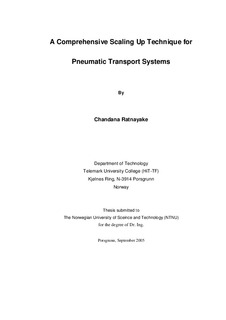A comprehensive scaling up technique for pneumatic transport systems
Doctoral thesis, Peer reviewed
Permanent lenke
http://hdl.handle.net/11250/2437803Utgivelsesdato
2005Metadata
Vis full innførselSamlinger
Sammendrag
The main objective of this investigation was to formulate a comprehensive scaling up technique for designing of pneumatic conveying systems by addressing the whole pipeline together with all accessories. Five different bulk materials together with five qualities of one of these materials have been used for the tests. A large number of pneumatic conveying tests has been conducted for five different pipeline configurations. In order to develop a model for pressure drop prediction in different sections of pipeline i.e., horizontal, vertical, bends, valves, etc, the gas-solid flow has been considered to be a mixture having its own flow characteristics. The classical Darcy- Weisbach's equation has been suitably modified and used for prediction of pressure drop of gas-solid mixture. The concept of suspension density and pressure drop coefficient has been introduced. Two separate models for pressure drop determination have been proposed. While one is used for both horizontal and vertical straight pipe sections, other is used for bends, valves or any other pipe section, which are considered as individual units. It has been shown that the proposed model performs much better than other scaling up techniques considered under the present study. Using dimensional analysis, a model has been formulated to scale up the pressure drop incurred at the entry section of a top discharge blow tank. The proposed model predicts the entry pressure losses within a maximum error margin of ±15% of experimental measurements. Since no other model was found in the open literature for such prediction, the proposed model could not be compared with any other. To determine the minimum conveying velocity, a scaling up model has been proposed using multivariate data analysis techniques and dimensional analysis. The proposed model gives resoably better predictions, especially in case of fine particles, than the other available models considered in this study. It also shows a good agreement with experimental measurements. Combining the models proposed in current study for pressure drop determination, entry loss calculation and minimum conveying velocity estimation, one can reliably design a complete pneumatic conveying system. Computational fluid dynamics (CFD) principles have been used to determine the pressure drop across a standard 90º bend and a straight pipe section. A commercial software code; Fluent® has been used for the investigation. Eulerian approach has been used for the simulation and the results show that the tested software can be used as an effective tool to determine the pressure drop in pneumatic conveying systems.
Beskrivelse
Avhandling (dr.ing.) - Høgskolen i Telemark / Norges teknisk-naturvitenskapelige universitet
